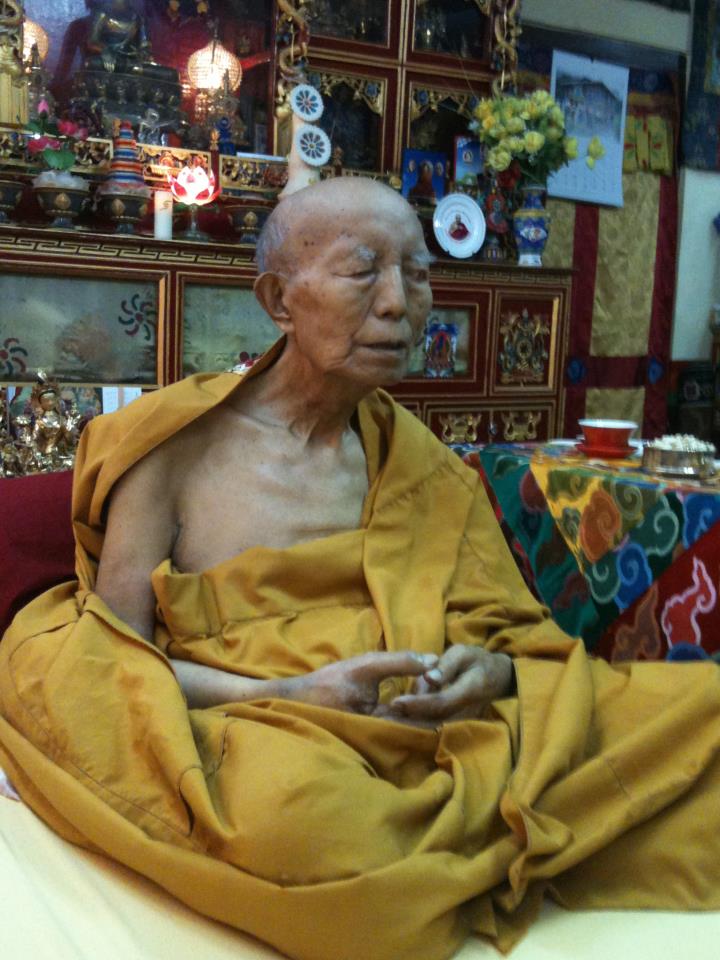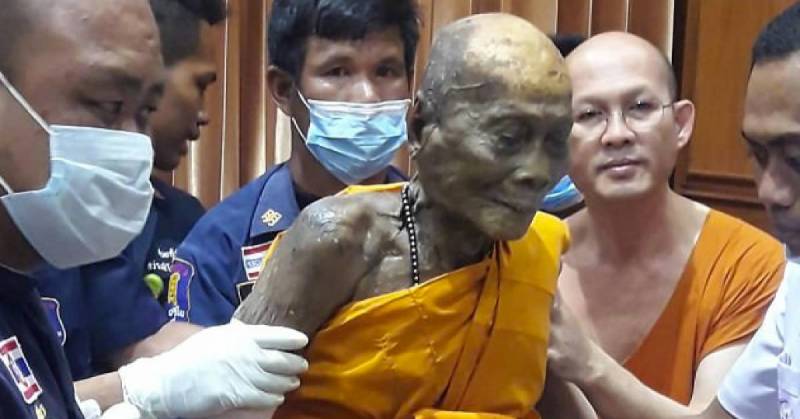CarderPlanet
Professional
- Messages
- 2,552
- Reaction score
- 710
- Points
- 83
They hacked death! And now I'm not talking about British scientists, but about the most real Buddhist monks. What is tukdam? The path to immortality, or just fake clownery? Let's go figure it out!
Introduction
I promised to tell you in more detail about Buddhism, which is exactly what I am going to do. True, we will start not with theoretical foundations (you can read about them yourself), but with the most unusual and interesting phenomena of Buddhism. By the way, thanks to one of the subscribers for throwing a good idea.

So, our topic today is related to Buddhist monks. You've all seen them - bald guys with a serene face who meditate all day, eat one morning dew and distribute quotes for women's publics on social networks. And also many mystical stereotypes are associated with them. As if with the help of meditation they can levitate, change the temperature of the body, and even become Professor H. But this is all garbage, since there is no real evidence of their superpowers. Except for one thing.

Tukdam
What is tukdam? This is posthumous meditation. It sounds strange, but it reflects the essence. Tukdam is the main way for Buddhist monks to retire to the next world. The bottom line is what. Imagine a grandfather of a monk who is 100 years old. This is not an ordinary monk, but a lama - a spiritual mentor and a person who has achieved that very Buddhist enlightenment. And now he feels that it is time to get ready for the afterlife. It means that he sits in the lotus position and dies. Literally. Not immediately, of course, but it is just as difficult to determine at what point he died. From the outside it looks absolutely normal. It was as if grandfather had just plunged into a deep meditative state. Just a stone face immersed in deep thought. Posture is present and the lotus posture is not disturbed in any way. Just a quality old man's meditation. But no, his heartbeat is absent, as are any other signs of life. Okay, he died and died. In general, it is not surprising, because age is all the same. Maybe during meditation a blood clot or something just came off.

But the most interesting thing happens afterwards. The body of such a monk who has committed tukdam decomposes in a completely different way from an ordinary corpse. Rather, it hardly decomposes - no rotting tissue, beetles, unpleasant odor, and so on. In addition, neither cadaveric spots nor rigor mortis remain. The skin also continues to be elastic for a long time. Over time, the body, of course, shrinks and becomes like a mummy. A very well preserved mummy. But it is by no means hidden in a sarcophagus. And they put it in a special open altar, from which the lama, as it were, watches everything that happens.

What's the trick?
As a result, we get two elements of mysticism. First, how did a person die in such peace? After all, a sudden heart attack, or the failure of vital organs would certainly be reflected in the facial expression, which, in theory, should depict at least some emotions. But no, visually, the lama just continues to meditate. The second is decomposition. How can it be that the body is automatically self-embalming? Some kind of magic. In general, this would be the explanation of the monks themselves. Supposedly meditation and all this enlightenment are capable of deceiving death and other physiological processes. Buddhists claim that in the state of tukdam, the lama continues his posthumous existence in a meditative state, and his body becomes incorruptible. A beautiful story. But what if it's all fake? For example, the distorted faces of the corpses are somehow corrected, and the bodies are simply artificially embalmed. The goal is clear - advertising. This "miracle" attracts many tourists to Tibet, who are also potential followers and, of course, purses to finance the life of the temple. Scientists from many countries also acquired a certain amount of skepticism, so they went to Tibet in order to find out what and how. They did not find out absolutely anything, and the idea that some unknown substance is formed in the monks' bodies, which protects tissues, was an adequate explanation for the non-disclosure of the body. So-so version, from which we conclude that either the scientists were slightly paid, or some unimaginable magic is really going on in Tibet. Scientists from many countries also acquired a certain amount of skepticism, so they went to Tibet in order to find out what and how. They did not find out absolutely anything, and the idea that some unknown substance is formed in the monks' bodies, which protects tissues, was an adequate explanation for the non-disclosure of the body. So-so version, from which we conclude that either the scientists were slightly paid, or some unimaginable magic is really going on in Tibet. Scientists from many countries also acquired a certain amount of skepticism, so they went to Tibet in order to find out what and how. They did not find out absolutely anything, and the idea that some unknown substance is formed in the monks' bodies, which protects tissues, was an adequate explanation for the non-disclosure of the body. So-so version, from which we conclude that either the scientists were slightly paid,

But tukdam does not end with one posthumous meditation. The tukdam ritual also includes the meditation of other monks next to the dying lama. Thus, they supposedly absorb the energy of the deceased.

Outcome
Tukdam is quite an interesting and, at the moment, inexplicable thing. You can look for tricks in it, or you can just fall into romance and believe in the magic of Buddhism. Be that as it may, the fact that a monk calmly dies during meditation, and his body decays, has not yet been refuted. So, who wants to die in a state of tukdam, be sure to unsubscribe in the comments. See you in new posts!
Introduction
I promised to tell you in more detail about Buddhism, which is exactly what I am going to do. True, we will start not with theoretical foundations (you can read about them yourself), but with the most unusual and interesting phenomena of Buddhism. By the way, thanks to one of the subscribers for throwing a good idea.

So, our topic today is related to Buddhist monks. You've all seen them - bald guys with a serene face who meditate all day, eat one morning dew and distribute quotes for women's publics on social networks. And also many mystical stereotypes are associated with them. As if with the help of meditation they can levitate, change the temperature of the body, and even become Professor H. But this is all garbage, since there is no real evidence of their superpowers. Except for one thing.

Tukdam
What is tukdam? This is posthumous meditation. It sounds strange, but it reflects the essence. Tukdam is the main way for Buddhist monks to retire to the next world. The bottom line is what. Imagine a grandfather of a monk who is 100 years old. This is not an ordinary monk, but a lama - a spiritual mentor and a person who has achieved that very Buddhist enlightenment. And now he feels that it is time to get ready for the afterlife. It means that he sits in the lotus position and dies. Literally. Not immediately, of course, but it is just as difficult to determine at what point he died. From the outside it looks absolutely normal. It was as if grandfather had just plunged into a deep meditative state. Just a stone face immersed in deep thought. Posture is present and the lotus posture is not disturbed in any way. Just a quality old man's meditation. But no, his heartbeat is absent, as are any other signs of life. Okay, he died and died. In general, it is not surprising, because age is all the same. Maybe during meditation a blood clot or something just came off.

But the most interesting thing happens afterwards. The body of such a monk who has committed tukdam decomposes in a completely different way from an ordinary corpse. Rather, it hardly decomposes - no rotting tissue, beetles, unpleasant odor, and so on. In addition, neither cadaveric spots nor rigor mortis remain. The skin also continues to be elastic for a long time. Over time, the body, of course, shrinks and becomes like a mummy. A very well preserved mummy. But it is by no means hidden in a sarcophagus. And they put it in a special open altar, from which the lama, as it were, watches everything that happens.

What's the trick?
As a result, we get two elements of mysticism. First, how did a person die in such peace? After all, a sudden heart attack, or the failure of vital organs would certainly be reflected in the facial expression, which, in theory, should depict at least some emotions. But no, visually, the lama just continues to meditate. The second is decomposition. How can it be that the body is automatically self-embalming? Some kind of magic. In general, this would be the explanation of the monks themselves. Supposedly meditation and all this enlightenment are capable of deceiving death and other physiological processes. Buddhists claim that in the state of tukdam, the lama continues his posthumous existence in a meditative state, and his body becomes incorruptible. A beautiful story. But what if it's all fake? For example, the distorted faces of the corpses are somehow corrected, and the bodies are simply artificially embalmed. The goal is clear - advertising. This "miracle" attracts many tourists to Tibet, who are also potential followers and, of course, purses to finance the life of the temple. Scientists from many countries also acquired a certain amount of skepticism, so they went to Tibet in order to find out what and how. They did not find out absolutely anything, and the idea that some unknown substance is formed in the monks' bodies, which protects tissues, was an adequate explanation for the non-disclosure of the body. So-so version, from which we conclude that either the scientists were slightly paid, or some unimaginable magic is really going on in Tibet. Scientists from many countries also acquired a certain amount of skepticism, so they went to Tibet in order to find out what and how. They did not find out absolutely anything, and the idea that some unknown substance is formed in the monks' bodies, which protects tissues, was an adequate explanation for the non-disclosure of the body. So-so version, from which we conclude that either the scientists were slightly paid, or some unimaginable magic is really going on in Tibet. Scientists from many countries also acquired a certain amount of skepticism, so they went to Tibet in order to find out what and how. They did not find out absolutely anything, and the idea that some unknown substance is formed in the monks' bodies, which protects tissues, was an adequate explanation for the non-disclosure of the body. So-so version, from which we conclude that either the scientists were slightly paid,

But tukdam does not end with one posthumous meditation. The tukdam ritual also includes the meditation of other monks next to the dying lama. Thus, they supposedly absorb the energy of the deceased.
Outcome
Tukdam is quite an interesting and, at the moment, inexplicable thing. You can look for tricks in it, or you can just fall into romance and believe in the magic of Buddhism. Be that as it may, the fact that a monk calmly dies during meditation, and his body decays, has not yet been refuted. So, who wants to die in a state of tukdam, be sure to unsubscribe in the comments. See you in new posts!
